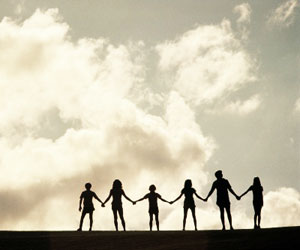Shared Pain Brings People Together
What doesn’t kill us may make us stronger as a group, according to findings from new research published in Psychological Science, a journal of the Association for Psychological Science.
The research suggests that, despite its unpleasantness, pain may actually have positive social consequences, acting as a sort of “social glue” that fosters cohesion and solidarity within groups:
“Our findings show that pain is a particularly powerful ingredient in producing bonding and cooperation between those who share painful experiences,” says psychological scientist and lead researcher Brock Bastian of the University of New South Wales in Australia. “The findings shed light on why camaraderie may develop between soldiers or others who share difficult and painful experiences.”
 Bastian and colleagues Jolanda Jetten and Laura J. Ferris of the University of Queensland examined the link between pain and social bonding in a series of experiments with undergraduate students.
Bastian and colleagues Jolanda Jetten and Laura J. Ferris of the University of Queensland examined the link between pain and social bonding in a series of experiments with undergraduate students.
In the first experiment, the researchers randomly assigned 54 students to perform either a painful task or a similar, relatively painless, task in small groups. The students submerged their hand in a bucket of water and were tasked with locating metal balls in the water and placing them into a small underwater container. For some, the water was painfully cold, while for others the water was room temperature.
A second task required the students to either perform an upright wall squat (which is typically painful) or to balance on one leg, with the option of switching legs and using balance aids to avoid fatigue.
The students then rated statements designed to measure how they felt about their group (e.g., “I feel part of this group of participants,” “I feel a sense of loyalty to the other participants”).
The students who performed the painful tasks and those who performed the painless tasks showed no difference in positive or negative emotion.
They did, however, show significant differences in group bonding: Students who performed the painful tasks reported a greater degree of bonding than did those who performed the pain-free versions, even after the researchers accounted for participant age, gender, and the size of the group.
And the researchers found that shared pain not only increases a sense of solidarity, it can also boost actual group cooperation.
In an experiment with another set of students, each group played a game that involved choosing numbers between 1 and 7 — if everyone in the group chose 7, they would get the highest payoff. But, if they chose different numbers, those who picked lower numbers would get a greater payoff. The researchers found that students who had performed painful tasks as a group tended to pick higher numbers than those who performed the pain-free tasks, suggesting that they were more motivated to cooperate with the group.
“This finding puts the ‘pain as social glue’ hypothesis to a rigorous test, highlighting that people not only feel closer to others, but are willing to risk their own outcomes to benefit the group,” says Bastian.
Shared pain even enhanced cooperation when the painful task involved eating a very spicy Bird’s Eye chili pepper.
The researchers point out that the groups, created by random assignment, did not reflect any sort of shared identity other than their task-related experiences. The pain experienced by some of the students seemed to serve a unique causal function, focusing the students’ attention on the shared pain and, ultimately, promoting group cohesion.
These findings offer insight into many social, religious, and even sexual practices around the world that involve some element of pain. But the researchers argue that the findings may be relevant in a much broader sense to many of our everyday experiences:
“These kinds of painful experiences may be relatively common,” notes Bastian. “Our findings therefore may have implications for understanding social processes apparent in settings such as boot camp-style physical training programs, team sports, executive challenges, and other physically challenging experiences shared with others. Sharing a spicy meal with friends may even have positive social consequences!”
This research was supported by Australia Research Council Discovery Grant DP140103716 (awarded to B. Bastian and J. Jetten).
All data and materials have been made publicly available via Open Science Framework and can be accessed at http://osf.io/9k3sw. The complete Open Practices Disclosure for this article can be found at http://pss.sagepub.com/content/by/supplemental-data. This article has received badges for Open Data and Open Materials. More information about the Open Practices badges can be found at https://osf.io/tvyxz/wiki/view/ andhttp://pss.sagepub.com/content/25/1/3.full.





Comments
I had suspected this to be true after walking two Camino trails. Thank you for this clear and simple appraisal of the story of pain and intimacy.
Surprisingly, this is very true. As of recently, hostage negotiators are using this to bond hostages and hostage takers. Also look at Stockholm Syndrome. Very interesting. Read more about this.
Im doing a research prodject on this and helps s much. I encourage others to read this.
APS regularly opens certain online articles for discussion on our website. Effective February 2021, you must be a logged-in APS member to post comments. By posting a comment, you agree to our Community Guidelines and the display of your profile information, including your name and affiliation. Any opinions, findings, conclusions, or recommendations present in article comments are those of the writers and do not necessarily reflect the views of APS or the article’s author. For more information, please see our Community Guidelines.
Please login with your APS account to comment.